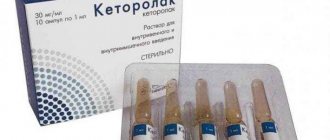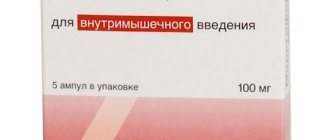Pain is a symptom of many injuries and diseases, which is why the need for painkillers in modern society is so high. The drug "Ketorol" is considered a good choice. Of course, treatment should be aimed at eliminating the primary cause. However, the pain can sometimes be simply unbearable, so patients need this medicine or its equivalent. "Ketorol" is considered a fairly effective remedy. Naturally, patients collect additional information about the drug.
In particular, it is worth learning about how the medicine affects the body. In what cases does the drug or its analogue help? Is Ketorol safe or can it cause any side effects? Are there any contraindications? The answers to these questions are of interest to many readers.
Composition and release form
This medication is available in the following forms:
- Solutions for intramuscular and intravenous use: transparent liquid, yellowish in color, 1 ml in ampoules, 10 or 5 ampoules in trays, 2 or 1 tray in cardboard packaging; 2 ml in dark glass ampoules, 10 pieces in a cardboard box.
- Ketorolac solution for intramuscular use: transparent, light yellow, 1 ml in glass ampoules, 5 ampoules in pallets, 2 or 1 pallet in a cardboard box, or 10 or 5 ampoules in a cardboard box; 2 ml in dark glass ampoules, 10 pieces in a cardboard pack.
1 ml of medicinal solution for intramuscular and intravenous use contains:
- active ingredient: ketorolac trometamol (ketorolac tromethamine);
- additional components with auxiliary functions: disodium edetate (disodium salt 2-aqueous ethylenediamine-N,N,N',N'-tetraacetic acid), sodium chloride, injection water.
1 ml of solution for intramuscular use contains:
- active element: ketorolac trometamol;
- excipients: edetate disodium dihydrate (Trilon B), ethanol (ethyl alcohol converted to anhydrous), sodium chloride, propylene glycol, sodium hydroxide.
Pharmacological properties
According to the instructions for use for Ketorolac injections, the drug belongs to the category of anti-inflammatory non-steroidal drugs. It has strong anti-inflammatory, analgesic and slight antipyretic properties. The mechanism of pharmacological action of this drug is the non-selective inhibition of the functionality of the enzymes COX-2 and COX-1 in areas of peripheral tissues.
As a result, the process of suppressing modulators of pain, inflammation and thermoregulation of prostaglandins begins. The drug does not have a direct effect on opioid receptors, does not contribute to the development of addiction, does not inhibit the functions of the respiratory organs, and does not have a sedative or anxiolytic effect. The analgesic properties of the drug significantly exceed the effects of other NSAIDs and are comparable to the effects of morphine.
The effect of Ketorolac injections is described in detail in the instructions.
The medicine immediately enters the general bloodstream when injected. Its bioavailability is 80-100%. The highest concentration in the blood is reached after approximately 20 minutes. The ability to form bonds with plasma proteins is 98%. Medicinal substances can penetrate the placental barrier and into breast milk.
It undergoes metabolic processes in the liver, 93% is excreted in urine and 4% in feces. It is not excreted by hemodialysis. The half-life of this drug is from 3 to 10 hours. What else does the instructions for use for Ketorolac injections tell us?
The drug "Ketorol": instructions for use (tablets)
How to take the medicine correctly? You should not use it yourself. Only a doctor can determine the effective and safe dose of Ketorol. Instructions for use (tablets) indicate that if pain occurs, patients take one tablet once.
In case of severe pain, the drug can be taken repeatedly. The maximum daily dose is 40 mg of the active ingredient, which is equal to four tablets. When taken orally, therapy should not last more than five days, as the risk of complications increases.
How to properly use Ketorol injection solution? The injections are given intramuscularly, and the patient is prescribed a minimal but effective dose. As a rule, a person over 16 years of age whose weight exceeds 50 kg is either administered 60 ml of the drug once, or the daily dose is divided into two doses (30 ml each). The injection should be done slowly, and it is important to inject the solution deep into the muscle. How quickly does pain disappear after taking Ketorol? Reviews say that the condition begins to improve 20-30 minutes after the injection. The maximum effect occurs within 1-2 hours and lasts approximately 4-6 hours.
Indications for use
The drug is prescribed for pain syndromes of severe and moderate severity, including toothache, trauma, postoperative pain; pain syndrome in oncological diseases, myalgia, neuralgia, arthralgia, radiculitis, rheumatic diseases, sprains, dislocations.
Not everyone knows what Ketorolac injections help with.
The medication has no effect on the progression of the pathological process. This medication should be used only for symptomatic therapy, to reduce the severity of the inflammatory process and pain at the time of use.
How quickly does ketorolac work?
When the pain is very strong, you really want it to ease up as soon as possible - this is a completely natural desire. When ketorolac is injected into a vein, relief in some cases can occur in just a few minutes, and the maximum effect is achieved after about an hour. The analgesic effect lasts for several hours (4-6). When administered intramuscularly, the drug begins to act somewhat later.
Much also depends on the intensity of the pain syndrome. After all, it, as a rule, depends on the activity of mediators of the inflammatory process - prostaglandins. The more of these substances in the body, the more difficult it will be for the drug to neutralize them. With a mild pain syndrome, relief occurs within 20 minutes, with a moderate pain syndrome – after 30 minutes, but severe pain can sometimes subside only after an hour.
We invite you to familiarize yourself with White plaque on the back of the throat photo - ENT and Colds
Increasing the dose does not affect the strength of the analgesic effect of ketorolac, nor the speed of its onset, but it can prolong (though not in proportion to the increase in dose, but to a much lesser extent) the duration of the drug’s effect.
The maximum concentration and time to reach it for the drug for various types of administration
| type of administration | dose, mg | concentration µg/l | time to reach concentration, min |
| intramuscular | 30 | 1,74-3,1 | 15-73 |
| intramuscular | 60 | 3,23-5,77 | 30-60 |
| intravenous | 15 | 1,96-2,98 | 0,4-1,8 |
| intravenous | 30 | 3,69-5,61 | 1,1-4,7 |
The equilibrium concentration of the drug when administered 30 mg 4 times a day is achieved after 24 hours.
Contraindications
Is Ketorolac injections allowed during breastfeeding?
The medication is contraindicated for use in the following pathological conditions:
- rhinitis or allergic reactions in the form of skin rashes caused by taking anti-inflammatory non-steroidal medications (history);
- partial or complete combination of recurrent sinus polyposis and bronchial asthma with signs of intolerance to acetylsalicylic acid or other anti-inflammatory non-steroidal drugs (including in the past);
- hypovolemia, fluid loss (regardless of the reasons that caused these pathologies);
- intolerance to medications of the pyrazolone group;
- bleeding, high probability of their occurrence;
- cases of confirmed hyperkalemia;
- conditions after coronary artery bypass surgery;
- peptic ulcers;
- erosive or ulcerative lesions of the digestive system (in the process of exacerbation), inflammatory bowel diseases;
- hypocoagulation (including hemophilia);
- cases of severe renal failure (with creatinine clearance less than 30 ml);
- hemorrhagic stroke (diagnosed or suspected);
- active liver pathologies or severe liver failure;
- disorders of hematopoietic processes;
- age less than 16 years (the safety and effectiveness of the drug for this age category of patients have not been established);
- hemorrhagic diathesis;
- period of pregnancy or breastfeeding;
- birth process;
- high sensitivity to substances from the drug, as well as to other anti-inflammatory non-steroidal medications.
When treating chronic pain, Ketorolac injections from Solopharm are not recommended. Due to the high probability of bleeding, the drug is not used as a medicine for premedication, anesthesia, or pain relief during surgical interventions (including in obstetric practice).
Ketorolac in ampoules is used with caution for the following conditions:
- bronchial asthma;
- high blood pressure;
- chronic heart failure;
- cholecystitis;
- impaired renal function;
- cholestasis;
- active forms of hepatitis;
- sepsis;
- lupus erythematosus;
- cerebrovascular pathologies;
- polyps of the mucous membrane of the nose and nasopharynx;
- simultaneous use with other non-steroidal anti-inflammatory drugs;
- the presence of factors that increase the toxicity of the digestive tract, including alcoholism and tobacco smoking;
- edema syndrome;
- dyslipidemia, hyperlipidemia;
- postoperative period;
- cardiac ischemia;
- pathology of peripheral arteries;
- history of gastrointestinal ulceration;
- diabetes;
- presence of Helicobacter pylori infection in the body;
- severe somatic diseases;
- old age (after 65 years);
- long-term use of anti-inflammatory non-steroidal medications;
- simultaneous use of oral glucocorticosteroids (for example, prednisone), anticoagulants (warfarin), antiplatelet agents (clopidogrel), some selective agents that inhibit serotonin reuptake (including citalopram, paroxetine, sertraline).
This is confirmed by the instructions for use of Ketorolac in injections.
Overdose
Symptoms of overdose are increased side effects (nausea, vomiting, impaired renal function, headache, increased blood pressure). Metabolic acidosis or alkalosis, respiratory depression, confusion and coma may develop. There is no specific antidote. Treatment is symptomatic; gastric lavage is indicated in the first hours. It is possible to use enterosorbents and osmotic laxatives. Hemodialysis and forced diuresis are not effective due to the high degree of binding of the drug to blood proteins.
Method of use and dosage regimen
The pharmacological drug “Ketorolac” in solution is administered intravenously (in a stream) in a slow flow (at least 15 seconds) or deep intramuscularly in the minimum effective dosage, which is selected by a specialist depending on the severity of the pain syndrome and the patient’s response. If necessary, simultaneous use with opioid analgesics in reduced dosages is permitted.
Depending on the severity of the pain syndrome, a single adult dosage (intramuscular or intravenous) ranges from 10 to 30 mg. Patients over 65 years of age or with changes in kidney function are usually prescribed 10-15 mg.
When repeatedly administering parenterally the drug “Ketorolac” in ampoules, the following dosing rules apply:
- Intramuscular administration: for patients under 65 years of age and after 16 years of age - 10-60 mg at the first injection, then - at intervals of 6 hours, 10-30 mg; for elderly patients (after 65 years) or for impaired renal activity - 10-15 mg every 6 hours.
- Intravenous administration: for patients under 65 years of age and over 16 years of age - 10-30 mg for the first injection, in a stream, subsequently - 10-30 mg every 6 hours, the initial dosage for continuous infusion using an infusion pump - 30 mg, after which the rate infusion should be 5 mg per hour; for elderly patients (after 65 years) or for kidney disorders - every 6 hours, 10-15 mg as a bolus.
The maximum daily dosage of Ketorolac injections for intravenous and intramuscular administration is:
- under 65 years of age and children over 16 years of age – 90 mg;
- elderly patients (after 65 years) or with impaired renal function - 60 mg.
Continuous intravenous administration should not last more than 24 hours. The duration of the course is no more than 5 days. When transferring a patient from intravenous and intramuscular administration to taking the drug Ketorolac orally, the total daily dosage per day should not exceed that administered by injection.
Price
You can purchase the drug Ketorol in pharmacies. The price of a package containing 10 ampoules is 121-130 rubles.
As substitutes for Ketorol, it is allowed to use drugs that have similar pharmacological effects:
| Ketorol's analogs | |
| Drug name | Price, rubles |
| Ketorolac | 112 |
| Ketanov | 245 |
| Dolak | 37 |
| Ketocam | 68 |
Ketocam
Ketorolac
Dolak
Ketanov
Side effects
During the period of use of the described pharmacological drug, the following body disorders may develop:
- Peripheral and central nervous system: drowsiness, cephalgia, dizziness; aseptic meningitis (including fever, convulsions, migraines, stiff neck), excessive activity (including severe anxiety, mood swings), depressive disorders, hallucinations, psychosis.
- Respiratory system: dyspnea, pulmonary edema, bronchospasm, rhinitis, swelling of the laryngeal tissue (including difficulty breathing, shortness of breath).
- Heart and blood vessels: increased pressure, fainting.
- Digestive system: gastralgia, diarrhea, flatulence, vomiting, stomatitis, constipation, feeling of excessive stomach fullness, nausea, loss of appetite, erosive and ulcerative lesions of the structures of the digestive tract (including those accompanied by bleeding or perforation - abdominal pain, melena, spasm in the epigastric zone , nausea, vomiting with blood, heartburn), cholestatic jaundice, liver inflammation, acute pancreatitis, hepatomegaly.
- Coagulation system: nasal or rectal bleeding, bleeding from postoperative wounds.
- Hematopoietic system: eosinophilia, leukopenia, anemia.
- Urinary system: lower back pain, acute renal failure, hematuria, azotemia, hemolytic-uremic syndrome (hemolytic anemia, thrombocytopenia, purpura), decreased or increased urine volume, edema of renal origin, frequent urination, nephritis.
- Skin: purpura, rashes (including maculopapular), exfoliative dermatitis (including fever, peeling, redness or thickening of the skin, swelling or tenderness of the tonsils), Stevens-Johnson syndrome, Lyell's syndrome.
- Sense organs: ringing in the ears, changes in visual functions (blurred vision), hearing loss.
- Local reactions: burning or pain at the injection site.
- Allergic phenomena - anaphylactoid reactions (including changes in facial skin tone, urticaria, skin rash, dyspnea or tachypnea, periorbital edema, swelling of the eyelids, shortness of breath, difficulty or wheezing).
- Other adverse reactions: weight gain, swelling (including of the face, ankles, legs, fingers, feet), increased sweating, swelling of the tongue, fever.
Description
Ketorol's active ingredient is ketorolac, a compound that pharmacists classify as a non-steroidal anti-inflammatory drug. As you know, non-steroidal anti-inflammatory drugs (NSAIDs) have three types of action - analgesic, antipyretic and anti-inflammatory.
Ketorolac is, one might say, a “specialist” among NSAIDs, dealing mainly only with counteracting pain. Its antipyretic and anti-inflammatory properties are rather weak. But in terms of analgesic effect, it surpasses all other non-steroidal drugs. Moreover, its action against pain can be compared with the action of recognized leaders among painkillers - drugs that excite opiate receptors of the central nervous system.
At the same time, ketorolac has a number of advantages compared to opiate analgesics. First of all, it does not cause drug dependence. In addition, ketorolac does not have an anxiolytic or sedative effect, does not depress the respiratory center, does not lead to urinary retention, and does not directly affect the cardiovascular system. All this means fewer contraindications and a wide range of application of the drug.
Special Recommendations
When using the drug "Ketorolac" simultaneously with other anti-inflammatory non-steroidal medications, decompensation of heart function, fluid retention, and increased blood pressure may occur. In order to reduce the likelihood of developing gastropathy caused by the use of these drugs, antacids, Misoprostol, and Omeprazole are prescribed.
The effect on platelet aggregation after administration of the drug "Ketorolac" persists for 48 hours. Hypovolemia increases the risk of negative side reactions from the urinary organs.
When concomitant therapy with paracetamol is used, Ketorolac should not be used for more than 3 days. For patients with impaired blood coagulation processes, the drug is prescribed only with constant monitoring of platelet volume, especially in the postoperative period, which requires careful monitoring of hemostasis. Due to the fact that most patients during treatment develop side effects from the central nervous system (dizziness, cephalalgia), performing work that requires high attention and speed of reactions (driving vehicles, working with machinery) is not recommended.
On the advantage of “injections” over “pills”
Injections have certain advantages when compared with tablets. All the benefits of this treatment are presented below:
- Speed and effectiveness of therapy. Drugs in tablet form can fully begin to act only after absorption in the intestine, but this takes time. Injections for intercostal neuralgia begin to work much faster if they are administered through a vein or muscle.
- The ability to deliver active substances to the required area. This is very effective during the introduction of a blockade, in other words, the injection of the drug into the muscle, which allows you to quickly relieve pain, and can also provide conductive anesthesia.
An injection for intercostal neuralgia is much more effective and is often used in medicine. But it is worth noting that not all types of neuralgia can be treated with injections. In some cases, injection is used to quickly deliver the medicine to the required places.
Injections for neuralgia can be used in a variety of ways, and you need to know the entire list of possible medications that doctors use for therapy.
Drug interactions
When the drug "Ketorolac" is used concomitantly with certain pharmacological agents, negative effects may occur. Acetylsalicylic acid or other anti-inflammatory non-steroidal substances, glucocorticosteroids, ethanol, calcium preparations, corticotropin cause the formation of ulcers of the digestive tract and the development of bleeding in the stomach and intestines.
Interaction with other drugs:
- Paracetamol: increased nephrotoxicity.
- "Methotrexate": increased nephro- and hepatotoxicity (simultaneous use is possible only at low doses while monitoring the concentration in the blood).
- Lithium, Methotrex: decreased clearance and increased toxicity.
- Heparin, indirect anticoagulants, thrombolytics, cefoperazone, antiplatelet agents, pentoxifylline and cefotetan: increased likelihood of bleeding.
- "Probenecid" and medications that can block tubular secretion: a decrease in the clearance of the drug "Ketorolac" and an increase in its concentration in the blood.
- Diuretic and antihypertensive drugs: decreased effectiveness.
- Opioid analgesics: increasing their activity.
- Oral hypoglycemic drugs and insulin: increased hypoglycemic effects (dose adjustment required).
- Valproic acid: changes in platelet aggregation.
- "Nifedipine", "Verapamil": increasing their concentration.
- Other nephrotoxic medications (including gold preparations): increased likelihood of developing kidney toxicity.
- Myelotoxic drugs: increased hematotoxicity.
The medication is contraindicated during breastfeeding.





